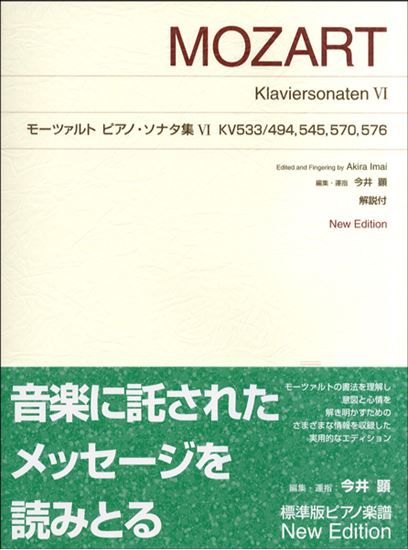Mozart, Wolfgang Amadeus : Sonate für Klavier Nr.17 Mov.1 Allegro
Work Overview
Genre:sonata
Total Playing Time:5 min 00 sec
Copyright:Public Domain
Commentary (2)
Author : Okada, Akihiro
Last Updated: March 5, 2019
[Open]
Author : Okada, Akihiro
Movement 1: D major, 6/8 time, Sonata Form
The main theme begins with an arpeggiated motif reminiscent of a horn, immediately repeated a second higher. This is followed by a statement of the theme (m. 9 ff.) in the bass, while a sixteenth-note passage appears in the upper voices. The transition section consists of two parts: first, a section with sixteenth-note passages (m. 16 ff.), and then a confirmatory transition (m. 28 ff.) in the dominant key of A major, where the horn-like motif of the main theme appears with an imitation delayed by one beat (canon at the perfect octave).
After a perfect cadence in the dominant key, a cantabile-style secondary theme appears (m. 42 ff.). After being stated with variations, it leads to a short coda, where a signal-like motif resounds at the end (m. 57).
The latter part (m. 59 ff.) begins with the signal-like motif that appeared at the end of the coda, and the main theme immediately appears in B-flat major. With an imitation delayed by one measure (canon at the perfect octave), it modulates to G minor, where it then develops with an imitation delayed by half a measure (three beats).
Passing through A minor and B minor via sixteenth-note passages, the signal motif reappears (m. 81 ff.). This motif is repeated in a sequential manner, shifting from B minor to E minor, then to A minor, suggesting D minor before leading to the tonic key of D major.
The sixteenth-note passages seamlessly connect to the recapitulation of the main theme (m. 99 ff.). The transition section is modified, and the motif that appeared in the upper voices during the statement of the main theme develops in a responsorial manner (m. 112 ff.). Immediately thereafter, the secondary theme is recapitulated in the tonic key (m. 122 ff.), followed by the imitative development of the main theme that played a confirmatory transitional role in the first half. Although the structure might be mistaken for a large-scale coda, the movement closes with a coda similar to that of the first half (m. 155 ff.).
Author : Ooi, Kazurou
Last Updated: October 9, 2025
[Open]
Author : Ooi, Kazurou
PTNA & Partner Channel Videos(3items)
Sheet Music
Scores List (9)

(株)全音楽譜出版社

(株)全音楽譜出版社

(株)全音楽譜出版社

(株)音楽之友社

(株)全音楽譜出版社

(株)ヤマハミュージックエンタテインメントホールディングス








